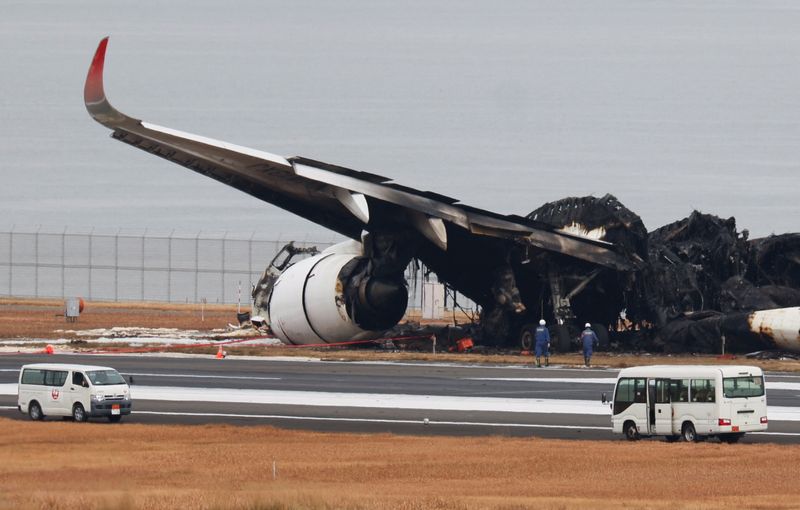By Tim Hepher, Allison Lampert, David Shepardson and Valerie Insinna
PARIS (Reuters) -A runway collision at Tokyo's Haneda airport has raised concerns over a gap in alerting technology, weeks after the global aviation industry faced new warnings about runway safety.
All 379 people aboard a Japan Airlines (JAL) (T:9201) Airbus A350 escaped following a collision with a Dash-8 Coast Guard turboprop that killed five of six crew on the smaller aircraft.
Experts have cautioned it is too early to pinpoint a cause and stress most accidents are caused by a cocktail of factors.
Investigators are examining conversations between controllers and pilots and are expected to embark in coming days on a detailed examination of plane and airport systems.
Japanese authorities said on Wednesday the A350 was given permission to land, but the Coast Guard plane was not cleared for take-off, based on control tower transcripts.
The crash marks the first significant accident involving the Airbus A350, in service since 2015, and the first destruction by fire of a new generation of carbon-composite airliner.
It comes weeks after a U.S.-based safety group called for global action to prevent a new uptick in runway collisions or "incursions" as skies become more congested.
"Despite efforts over the years to prevent incursions, they still happen," Flight Safety Foundation CEO Hassan Shahidi said in a statement.
"The risk of runway incursions is a global concern, and the potential consequences of an incursion are severe."
Although ground collisions involving injury or damage have become rare, their potential for loss of life is among the highest of any category and near-misses are more common.
A collision between two Boeing (NYSE:BA) 747s in Tenerife in 1977, killing 583 people, remains aviation's most deadly accident.
In 2016, a China Eastern Airbus A320 getting airborne from Shanghai missed hitting an A330 from the same airline as it taxied across the take-off runway just 19 metres below.
And a rash of near misses in the United States has led to the creation of an expert panel to address controller fatigue.
'TECHNOLOGY GAP'
The Washington-based Flight Safety Foundation says breakdowns in communication often play a role.
But a shortage of electronics to avoid collisions on the ground, rather than in the air where software to trigger avoidance has been available since the 1980s, is also a concern.
"Many of the serious incidents could have been avoided through better situational awareness technologies that can help air traffic controllers and pilots detect potential runway conflicts," Shahidi said.
The Federal Aviation Administration says 35 U.S. airports are fitted with a system called ASDE-X that uses radar, satellites and a navigation tool called multilateration to track ground movements.
But National Transportation Safety Board chair Jennifer Homendy said in November the U.S. - a bellwether for airports worldwide - lacks sufficient technology to prevent incursions.
In 2018, Airbus said it was working with Honeywell (NASDAQ:HON) on a system called SURF-A, or Surface-Alert, to help prevent runway collisions by giving pilots visual and audio warnings.
But no date for implementation has yet been announced and the idea has brushed up against reluctance from some airlines unwilling to bear the extra cost, while underlying reforms in U.S. and European air traffic systems have long been delayed.
"(The) primary concern about SURF is costs," one airline told a U.S. panel on air systems, according to a 2021 report.
Another commented: "Nothing can motivate investment; simply don't see a risk issue or benefit worthy of pursuit."
Airline groups had no immediate comment. Industry experts say flying often involves tricky choices of costs versus safety.
A person familiar with the technology said it had also been delayed by gaps in ADS-B tracking coverage on which it depends.
Development had also proved more challenging than the TCAS cockpit system which has been monitoring the threat of in-air collisions during flight for decades, due to the need to take into account multiple ground obstacles and systems.
In 2022, two firefighters were killed when their untracked vehicle hit a LATAM Airbus A320 during takeoff.
"The system is still under development," an Airbus spokesperson said.
The head of Honeywell's Aerospace Technologies division, Jim Currier, told Reuters the system went through a series of successful tests in December and should be certified and available to airlines "gradually over the next few years".
Although automated landings are increasing, experts say much still depends on visual checks by pilots who may be distracted by a high workload or the blur of a night-time runway.
"I think the investigation will focus a lot on the clearances ... and then also what the (JAL) crew could see. Could they physically see that airplane on the runway," said former U.S. air accident investigator John Cox.

Lighting was an issue in a 1991 collision between a USAir plane and SkyWest Airlines aircraft at Los Angeles International Airport in California, for example.
"One of the things that came out of that was that the USAir crew physically could not see the SkyWest Metroliner there. Although it was on the runway, the lighting was such that you … physically couldn’t see it," he said.
